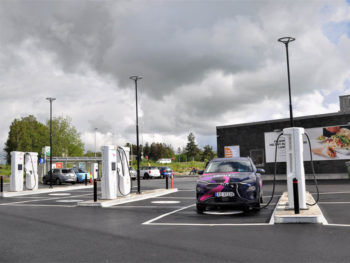EV charge point locations outnumber petrol stations
Figures from popular EV charge point mapping service Zap-Map, show that public charging locations now surpasses petrol stations for the first time.

New charge point locations have stemmed from companies including Ionity that has begun installing 350kW ultra-rapids in the UK
As of 22 May 2019, there were 8,471 charging locations across the UK, hosting 13,613 charging points, while at the end of April there were 8,400 petrol stations in the UK – a figure that Zap-Map says is continuing to decline.
In the last year alone, electric vehicle (EV) charge point locations has increased 57% and can now be found from the Shetland Islands to the Cornish Riviera, from Giant’s Causeway to the White Cliffs of Dover.
Just six years ago there were 3,500 EVs on UK roads, whereas today that figure is greater than 210,000. Forecasters have predicted that by the end of 2022, at least 1 million EVs will be in use in the UK, as backed up by the UK Government’s 2040 policy that says all new cars and vans should be electric.
However, a contradictory article by The Telegraph citing the charity Electrical Safety First claims that 75% of the 1,500 EV owners it surveyed have used an extension lead to charge their vehicle and consequently that there is a direct correlation between an alleged lack of charge points and unsafe charging.
Ben Lane, co-founder and CTO at Zap-Map commented: “The public and private sectors are now investing heavily in the UK’s EV charging infrastructure to ensure that there are sufficient charging points to support the growing electric fleet. This month’s milestone reveals the rapid pace of change already underway as the age of the combustion engine gives way to an all-electric era with vehicles offering both zero-emissions and a better driving experience.”
The news comes as several key new mass-produced electric cars enter the market including the Tesla Model 3 and forthcoming Volkswagen ID.3, which aim to appeal to mainstream buyers rather than catering for more wealthy and therefore smaller numbers of purchasers.
In addition, charge point speed is increasing with the introduction of new rates that are seven times faster than today’s 50kW rapid charger, offering speeds of 350kW for example at Ionity ultra-rapid charge points, although there are no cars as yet on the market that can take advantage of the technology.
Commenting on the data, Daniel Brown, EV Lead at the REA said: “On top of a growing number of on-street and destination charge points across the country, several new companies developing rapid charge points and charging ‘hubs’ have recently been founded or entered the UK market which will give further confidence to both consumers and fleets who wish to go electric.
“National and city-level strategic planning is currently underway and by the end of the year we will see the outputs of both Transport for London and the Government’s electric vehicle taskforces.
“The consumer experience of using public infrastructure is also improving, with four British charge point operators now connecting, so customers can use one RFID card to seamlessly roam across their networks.”
charge pointselectric vehiclesEVZap-Map
5 Comments
-
Robert Chisholm31. May, 2019
Let’s say fuel stations have an average of 8 pumps (4 stations with pumps either side) …. 8 x 8,400 = 67,200 individual refuelling points.
Did Diane Abbott do the calculations for this article?
-
Stuart Gumm31. May, 2019
Slightly mis-leading statistics. A petrol station can re-fuel hundreds of vehicles a day (a re-fuel takes about 15 minutes including paying), whereas a charging station may be used for a single vehicle for a number of hours. For electric vehicles to become universally accepted, charging points need to be present in every home (including flats with allocated spaces), company car parks, supermarket car parks and public pay and display car parks. Until that happens, I do not believe electric vehicles will fully replace petrol/diesel.













Gordon Christie03. Jun, 2019
This is a significant milestone no doubt, but not as significant as it is painted. The 8400 petrol/diesel stations, with 7.3 pumps per station, cater for the 40+ million drivers of such vehicles in the UK. The 8471 electric stations with 2.1 chargepoints each, on average, have a maximum capacity of 2 million vehicles, assuming an optimistic one-hour average turnaround and 24 hour availability.
Chargepoints in many multi-story car parks and company facilities are not accessible 24 hours/day – and aren’t the workplace chargepoints already included in the headline numbers, so they’re NOT additional capacity. And whereas petrol and diesel are effectively the same nationally, there are regional limitations for the various charge protocols (Tesla, Chademo, CCS, Type 2….. Try running a Nissan Leaf outside of the NE, London and the M1, for instance.
Regarding 350kW chargers, they’re currently a gimmick – easy to achieve on the supply side, unlikely to have a widespread implementation until the battery technology changes, or we find a way to stop lithium getting too excited. The weight penalty of a thermally regulated charging system is too great.
If we want wider use of EVs, we need more infrastructure, standard infrastructure, longer driving range (thankfully the automotive industry has stopped blaming the customer’s “range anxiety” and has recognized the “range deficiency” in its products), and more competitive pricing.